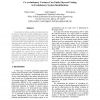396 search results - page 3 / 80 » How scientific models can explain |
DALT
2009
Springer
13 years 8 months ago
2009
Springer
Abstract. Virtual characters in games operate in a social context involving other characters and human players. If such socially situated virtual characters are to be considered be...
ICAIL
1997
ACM
13 years 9 months ago
1997
ACM
The capacity for self-explanation can makecomputer-drafted documents more credible, assist in the retrieval and adaptation of archival documents, and permit comparison of document...
FORTE
1996
13 years 6 months ago
1996
I discuss formal description techniques (FDTs) as they are applied in practice in software and system engineering. Their quality can be measured by their formality, descriptivenes...
EH
2005
IEEE
13 years 10 months ago
2005
IEEE
Co-evolution of system models and system tests can be used for exploratory system identification of physical platforms. Here we demonstrate how the amount of physical testing can ...
CORR
2006
Springer
13 years 4 months ago
2006
Springer
Abstract. Emergence--macro-level effects from micro-level causes--is at the heart of the conflict between reductionism and functionalism. How can there be autonomous higher level l...


